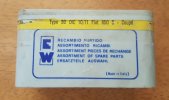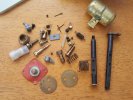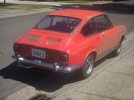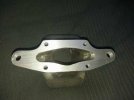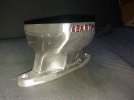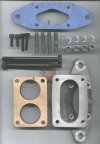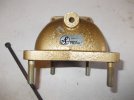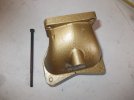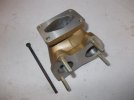Clean the idle jets, they're easy to do without removing anything from the car (except maybe the air filter housing, for easier access).
I recommend placing a towel under each side of the carb, in order to catch anything that may get dropped during the cleaning process. There's nothing worse than accidentally dropping the idle jet & having it fall into that little Bermuda Triangle down between the starter motor, the engine block & the flywheel plate (the jet & holder are non-magnetic, so you can't just fish it out with a telescoping magnet tool). Cover the carb venturii for good measure, as well.
If idle is still poor after doing this, with the engine running, spray some carb cleaner or brake cleaner
directly at the point where the main throttle shaft exits the carb body (right where the throttle linkage is). If the engine stumbles or speeds up, you have an air leak there (a worn shaft opening issue, as noted above by
fiatfactory). This is fixed by disassembling the carb & reaming the shaft openings for oversized bushings (aftermarket parts) or oversized throttle shafts (factory Fiat/Weber parts).
If nothing occurs after spraying the throttle shaft, spray carb/brake cleaner along the horizontal joint where the carb base meets the steel fuel splash tray (if still fitted) or the top of the intake manifold. Start at the main throttle shaft & work your way to the left towards the secondary shaft, then on around the entire base of the carb. If the engine stumbles or speeds up, you have an air leak. Slowly repeat the spraying process to better narrow down the exact location of the leak(s)- it will most likely be on the main linkage side of the carb between the 2 throttle shafts, as the carb base is prone to warping from owners over-tightening the carb-to-manifold bolts/nuts (this side gives easier access, thus a tendency towards over-tightening). Fixing this issue will require removing the carb & sanding (planing) the base flat. Not a difficult job, just requires focus (I can give you more detailed instructions on doing this correctly, if needed).
If none of these restore proper idle, other things to check would be the condition of the idle adjustment needle (crusty, worn, bent or broken needle tip), excessive play (wear) between the distributor shaft & its body or a worn/missing distributor shaft oil slinger (wobbly or bouncing distributor shaft, causing erratic timing).
These are all
much easier & cheaper to diagnose/fix than installing another type of power plant. Getting another carb/manifold won't fix the issue of sediment clogging jets, either. The 30DIC carb is perfectly fine for the car, it only gets maligned by so many people because they're too lazy or ignorant to fix the main underlying issue - a poor quality fuel supply. A rusty, crap-filled tank is the #1 cause of consistently-clogging carb jets on 850's. Fix the
cause & you'll never have to deal with the
effects that result from it. A couple days of dealing with it directly are more than worth the years of headache-free driving afterwards.
Clean the fuel tank, then clean it again.
Replace
all fuel hoses with NEW (not NOS) fuel hose.
Install a good
quality fuel filter both before & after the fuel pump.
Clean the carb & jets, then clean them again.
Adjust carb float level & idle mixture/speed screws as needed.
Use paper or quality foam air filters if possible (crumbly foam filter particles will clog air corrector, idle & main jets)
Check the condition of the air cleaner-to-carb top rubber gasket/insulator (crumbly rubber - see above).
A clean fuel system is worth its weight in gold on any engine, moreso on our little Fiat 600's & 850's.



